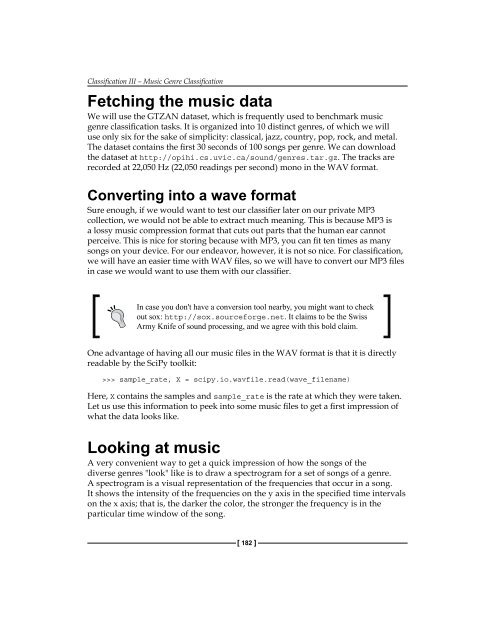1FfUrl0
1FfUrl0
1FfUrl0
Create successful ePaper yourself
Turn your PDF publications into a flip-book with our unique Google optimized e-Paper software.
Classification III – Music Genre Classification<br />
Fetching the music data<br />
We will use the GTZAN dataset, which is frequently used to benchmark music<br />
genre classification tasks. It is organized into 10 distinct genres, of which we will<br />
use only six for the sake of simplicity: classical, jazz, country, pop, rock, and metal.<br />
The dataset contains the first 30 seconds of 100 songs per genre. We can download<br />
the dataset at http://opihi.cs.uvic.ca/sound/genres.tar.gz. The tracks are<br />
recorded at 22,050 Hz (22,050 readings per second) mono in the WAV format.<br />
Converting into a wave format<br />
Sure enough, if we would want to test our classifier later on our private MP3<br />
collection, we would not be able to extract much meaning. This is because MP3 is<br />
a lossy music compression format that cuts out parts that the human ear cannot<br />
perceive. This is nice for storing because with MP3, you can fit ten times as many<br />
songs on your device. For our endeavor, however, it is not so nice. For classification,<br />
we will have an easier time with WAV files, so we will have to convert our MP3 files<br />
in case we would want to use them with our classifier.<br />
In case you don't have a conversion tool nearby, you might want to check<br />
out sox: http://sox.sourceforge.net. It claims to be the Swiss<br />
Army Knife of sound processing, and we agree with this bold claim.<br />
One advantage of having all our music files in the WAV format is that it is directly<br />
readable by the SciPy toolkit:<br />
>>> sample_rate, X = scipy.io.wavfile.read(wave_filename)<br />
Here, X contains the samples and sample_rate is the rate at which they were taken.<br />
Let us use this information to peek into some music files to get a first impression of<br />
what the data looks like.<br />
Looking at music<br />
A very convenient way to get a quick impression of how the songs of the<br />
diverse genres "look" like is to draw a spectrogram for a set of songs of a genre.<br />
A spectrogram is a visual representation of the frequencies that occur in a song.<br />
It shows the intensity of the frequencies on the y axis in the specified time intervals<br />
on the x axis; that is, the darker the color, the stronger the frequency is in the<br />
particular time window of the song.<br />
[ 182 ]


